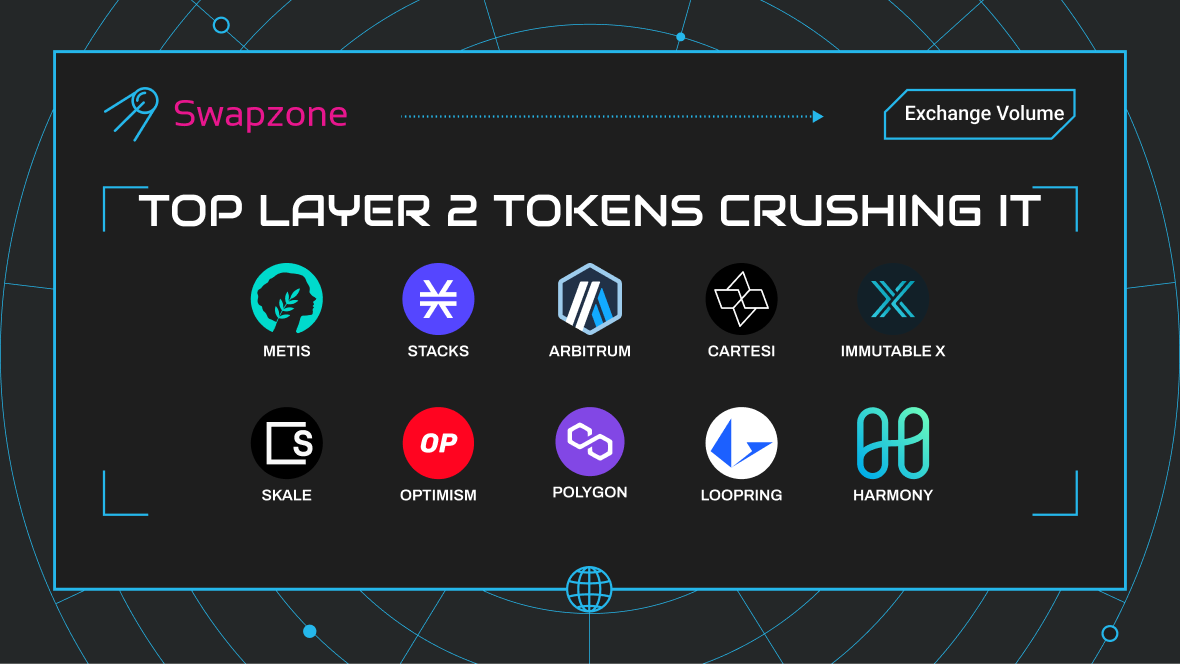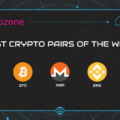Table of contents
Layer 2 tokens aren’t just surviving – they’re killing it.
While Ethereum’s mainnet is handling the heavy security lifting, Layer 2 tokens have become the go-to playground for traders looking for speed without sacrificing safety. The Layer 2 tokens now has a $13.1 billion market cap with daily volumes of $1.66 billion. But here’s what really matters: some Layer 2 tokens are seeing explosive volume growth, and everyone’s talking about it.
Let’s get into which Layer 2 tokens are dominating exchange volumes and why smart traders can’t stop talking about them.
Key Takeaways
- Layer 2 tokens like Starknet exploded with 477% trading volume surge to $317.43M after launching Bitcoin staking – proving innovation drives real capital flows
- Layer 2 tokens command $13.1 billion market capitalization with $1.66B daily volume, but the distribution isn’t equal – some are crushing it while others lag
- Arbitrum owns 51% of L2 market share with $3B TVL and 500+ protocols, making it the undisputed ecosystem king
- Mantle completed its ZK Rollup transition and became the largest with $20B+ TVL modular architecture is winning
- Transaction costs dropped from $50+ to under $1, making decentralized finance accessible to millions who couldn’t afford Ethereum’s gas fees before
- Layer 2 blockchains boosted Ethereum activity by 20% in 2025, and we’re just getting started with gaming, real-world assets, and Bitcoin L2 expansion on the horizon
The Top Layer 2 Tokens by Volume Growth
Starknet (STRK): The Dark Horse
Nobody saw this coming.
Starknet just saw a 477% surge in 24 hour trading volume to $317.43 million. This is not a typo. We’re talking about 5x normal volume in a day.
What’s driving this frenzy? The network launched non-custodial Bitcoin staking on its mainnet around September 30, 2025. This means Bitcoin holders can stake wrapped BTC to secure the Starknet network and earn STRK rewards. It’s like bridging the gap between Bitcoin’s massive liquidity and decentralized finance’s innovative possibilities.
The numbers speak for themselves:
- 30.55% weekly price increase
- Market cap of $745.97 million
- TVL up 56.8% in September to $256 million
- Daily transactions went from 150,000 in August to 900,000
Starknet uses zero-knowledge rollup technology, which is special. Unlike optimistic rollups that assume transactions are valid, ZK-rollups provide cryptographic proof immediately. It’s faster and more secure – a win-win.
Mantle (MNT): The Modular Powerhouse
Mantle isn’t messing around.
Trading volume hit $872.8 million in 24 hours with a 6.22% daily gain. But weekly performance tells the real story: 31% increase and everyone’s talking.
Here’s what makes Mantle unique. The network completed its transition to ZK Rollup architecture in September 2025 and is now the largest ZK Rollup with over $20 billion TVL. That’s not growth – that’s dominance.The modular design is the key here. By breaking transaction execution, data availability and settlement into separate modules, Mantle gets sub-second finality with 50% lower fees than before.
And there’s serious juice. The Mantle EcoFund has a $200 million capital pool backed by top VCs like Polychain and Dragonfly. That kind of money attracts good projects.
Arbitrum (ARB): The Steady Giant
Sometimes consistency beats flash.
Arbitrum is the leading Layer 2 with $3 billion in TVL and most daily active addresses among competitors. It doesn’t always make headlines with percentage gains but the sheer volume is impressive.
The network has 51% of the Ethereum Layer 2 market share in TVL as of January 2025. Think about that. More than half the market trusts Arbitrum with their money.
Why? Speed and efficiency matter. Arbitrum is 10x faster than Ethereum with peak throughput of 40,000 TPS and up to 95% gas savings. For traders making multiple moves a day, those savings add up fast.
Ecosystem depth can’t be ignored either. Over 500 DeFi protocols live on Arbitrum. That’s not just adoption – that’s entrenchment.
Base: The Coinbase-Backed Juggernaut
Base doesn’t have a native token yet. But the platform’s growth is worth mentioning because it’s changing the Layer-2 landscape.
Base set a record with 19.4 million new users in October 2024, adding 13.7 million – almost 8x more than second place Polygon. That’s user growth on steroids.
What’s the secret sauce? Coinbase integration gives Base something priceless: trust. New crypto users don’t need convincing when their exchange recommends a scaling solution. They just use it.
Base has surpassed Ethereum Layer 1 activity and now dominates retail trading. The platform processes more daily transactions than Ethereum itself. Let that sink in.
Polygon (POL): The Multi-Chain Maven
Don’t count Polygon out.
The network added 1.5 million super users in 2024 and 867.7 million super user transactions throughout the year. That’s almost double the super users of second place Base.
Here’s where Polygon stands out. While other Layer 2s focus on DeFi, Polygon has successfully branched into gaming and real-world applications. The chain has incentivized high transaction volume through GameFi and alternative use cases beyond DeFi.
The tech specs are still impressive. Polygon’s throughput is over 65,000 TPS with zkRollup and Proof-of-Stake consensus. That’s crazy throughput for a network that handles NFT marketplaces to supply chain tracking.
Optimism (OP): The Superchain VisionaryOptimism took a different approach.
Instead of competing for market share alone, Optimism built the “Superchain” concept – a broader ecosystem of Layer 2 networks that connect seamlessly between chains. It’s like building highways instead of just roads.
It’s working. The Optimism Superchain now hosts Base, Zora, Redstone, Fraxtal, and Mode. Anyone can create a new Layer 2 network and join. It’s open architecture at its finest.
The market liked this vision with a 6.26% market cap increase to $1.41 billion. Not explosive growth but steady and sustainable.
What’s Behind the Volume?
Layer 2 tokens are benefiting from several converging trends.
Several things are coming together to drive Layer 2 volumes up.
Lower Costs, More Activity
Ethereum gas fees can still go to $50+ during peak times. Layer 2 solutions are under $1. That’s not just cheaper – it’s accessible. More people can trade, stake and experiment with DeFi protocols.
Institutional Adoption Accelerates
Institutional involvement and on-chain data shows higher demand for scalability solutions. When institutions need blockchain solutions they can’t stomach Ethereum’s fees or wait times. Layer 2 networks provide the speed and cost structure institutions need.
Innovation Attracts Capital
Bitcoin staking on Starknet. ZK-rollup upgrades on Mantle. The Superchain on Optimism. These aren’t minor tweaks – they’re game-changers. Capital flows to innovation and Layer 2 networks are delivering it.
User Experience Improvements
Native account abstraction on networks like Starknet means passkeys, session keys and paymasters. Translation? Users can interact without managing seed phrases or signing every transaction. That’s Web2 level convenience with Web3 security.
Exchange Listings Multiply
Major centralized exchanges like Binance and Crypto.com have integrated with Layer 2 networks. When you can buy and trade Layer 2 tokens on major platforms, liquidity increases. Higher liquidity means tighter spreads and better execution – exactly what volume traders want.
The Tech Behind the Numbers
Why these tokens are working requires understanding the tech.
Optimistic Rollups vs ZK-Rollups
Two main approaches dominate Layer 2 scaling:
Optimistic rollups (Arbitrum, Optimism, Base) assume transactions are valid by default. They use a 7 day challenge window for verifiers to check transactions. This creates a slight delay for final settlement but is EVM compatible.
ZK-rollups (Starknet, Mantle post-upgrade) provide instant cryptographic proof of validity. No waiting period needed. They’re faster and more secure but historically harder to make EVM compatible.
The gap is closing though. Recent upgrades have made ZK-rollups nearly as developer friendly as optimistic ones.
Data Availability Solutions
Mantle’s data availability layer uses EigenLayer’s Ethereum protocol, enabling ETH restaking and supporting the network’s high transaction throughput. This modular approach lets networks optimize for different priorities: speed, security or cost.
Looking Ahead: What’s Next for Layer 2 Volume?
It’s looking good.
Layer 2 solutions have increased Ethereum activity by 20% in 2025. But we’re just getting started. Here are the catalysts:
Cross-Chain Interoperability
The Superchain model isn’t unique to Optimism anymore. Expect more Layer 2 networks to focus on seamless bridging. When moving assets between chains becomes easy, volume will go through the roof.
Real-World Asset Tokenization
Layer 2s will be the key to blockchain’s mass adoption through real-world asset tokenization. Imagine trading tokenized real estate or bonds on networks that process thousands of transactions per second for pennies per trade.
Gaming and Social Applications
Gaming projects on Starknet went from 4 to 51 in a single year, making it the largest category in the ecosystem. Games generate massive transaction volumes. As more move to Layer 2, volume will multiply.
Bitcoin Layer 2 Expansion
Starknet pioneered Bitcoin staking. Others will follow. All Bitcoin innovation must happen on Layer 2 since Bitcoin’s Layer 1 can’t support DeFi, privacy tools or smart contracts. That’s a multi-trillion dollar market waiting to unlock.
Key Takeaways for Traders and Investors
Here’s what you need to remember:
Volume is Conviction
Rising exchange volume isn’t just noise – it’s traders voting with their capital. When volume goes up 477% like Starknet’s did, something fundamental has changed.
Technology Matters
Networks upgrading to ZK-rollups or adding new features are capturing market share. Technical innovation drives volume growth.
Ecosystem Depth Wins Long-Term
Arbitrum has 500+ protocols and Polygon has multiple use cases. More apps attract more users, which attracts more devs. It’s a virtuous cycle.
Don’t Ignore the Undervalued
Despite lower usage metrics than Arbitrum, Optimism’s token is priced higher relative to its activity, so it’s priced for its ecosystem vision. Markets sometimes price in future potential before it happens.
Regulatory Clarity Helps
2025 is the year of mainstream Layer 2 adoption as user wallets become multi-chain by default. This normalization brings institutional capital that was sitting on the sidelines.
Final Thoughts
Layer 2 networks have gone from experimental to essential infrastructure. The volume growth we’re seeing isn’t a short term spike – it’s a fundamental change in how people use blockchain. Lower fees enable new use cases. Faster transactions improve user experience. Better technology attracts innovation.
Starknet’s Bitcoin staking shows what’s possible when networks think beyond incremental improvements. Mantle’s modular architecture proves technology matters. Arbitrum’s consistent dominance proves the depth of the ecosystem.
If you’re watching the crypto space, one thing is clear: Layer 2 is no longer the future. It’s the now. And the volume numbers prove it.
The question isn’t will Layer 2 networks continue to grow. It’s which ones will lead the next wave of innovation – and which traders will get in early.

